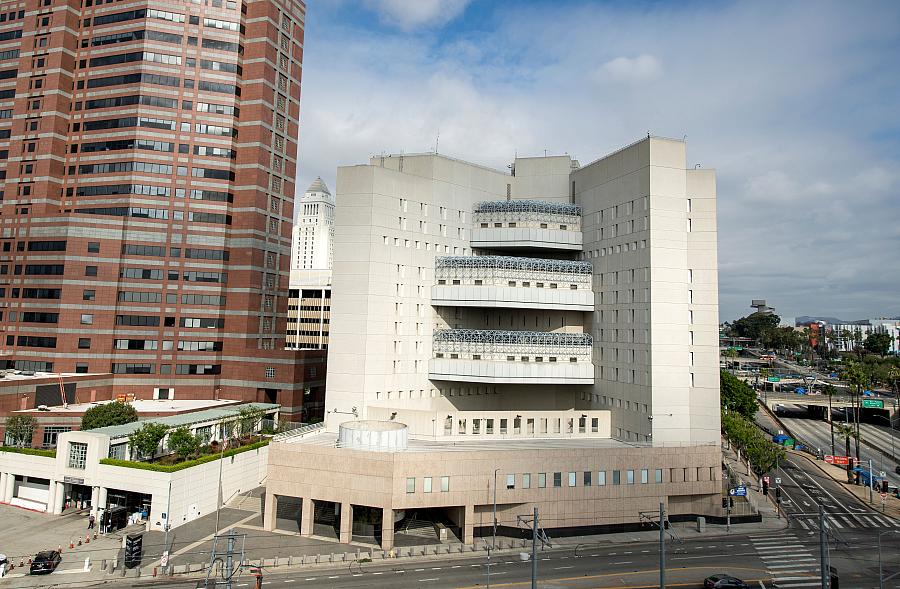Can Los Angeles County’s jail system take better care of mothers and their kids?

The Metropolitan Detention Center in downtown Los Angeles.
(Photo by Valerie Macon/AFP via Getty Images)
Approximately 80% of the 2.9 million women jailed annually in the U.S. are mothers. Most are the primary caregivers for their children. Approximately 150,000 of those held in women’s jails each year are pregnant.
As Los Angeles County shifts toward a “care first, jail last” model to replace its broken punishment-focused system, it’s critical that local leaders fully understand and prioritize the needs of mothers involved in the justice system and their children.
In past decades, policy and media attention has largely focused on the needs and experiences of men, who make up a much larger proportion of the nation’s jail and prison populations than women and non-cisgender people.
Yet women, especially Black women, have become the fastest-growing incarcerated population in the U.S., even as overall national incarceration numbers have steadily dropped. At the local level, Black women make up 33% of all women booked into LA County’s jail system, despite comprising just 9% of women in the county.
Pre-pandemic, LA’s jail system incarcerated more than 2,000 women daily, approximately half of whom were held pretrial.
According to a 2019 report from UCLA’s Million Dollar Hoods Project, between 2010 and 2016, the LA County Sheriff’s Department spent $752 million incarcerating 173,000 women for a combined 16,466 years.
The top five single charges for those women were relatively low-level offenses: drug possession, DUI, driving on a suspended or revoked license, sex work, and theft or shoplifting.
Incarcerated women are disproportionately survivors of violence and trauma. And research indicates that incarcerating mothers heaps trauma on their children, as well.
One 2014 study found that having a parent behind bars can be more damaging to a child’s well-being than divorce or even the death of a parent. Kids with incarcerated parents are also more likely to experience developmental delays, drop out of school, and become incarcerated themselves.
Moreover, when mothers return from lockup, they are more likely than their male counterparts to experience homelessness, unemployment, and other barriers to successful reentry — all of which negatively impact their children. Historically, most reentry programs have focused on the needs of men.
With these issues in mind, over the past five years LA County officials have worked to improve care for women — especially for pregnant and postpartum people — who come into contact with the jail system. And, among the 114 recommendations for building that “care first, jail last” model produced by the county’s Alternatives to Incarceration (ATI) workgroup in 2019, were suggestions for meeting the needs of those who are locked up while pregnant or shortly after giving birth, along with mothers and their kids.
My 2021 California Fellowship project will explore the county’s changes and how local parents and children have experienced them. I will also look at ways in which impacted community members feel the county could do more to bring about better care and outcomes for pregnant people, as well as mothers with young children.
There’s almost certainly more work to be done.
In December 2020, the ACLU found that approximately 20 pregnant individuals remained in jail despite efforts to reduce the jail population in response to the pandemic. Some reported being placed in solitary confinement to mitigate the risk of contracting COVID-19. At least five had tested positive for coronavirus.
My reporting will also look at whether the sheriff’s department’s policies and practices align with national guidance on incarcerating pregnant and postpartum people. I’ll seek to feature the stories and experiences of women jailed while pregnant — including those who have given birth while incarcerated — as well as those who have participated in county and community programs developed to reduce justice system contact and its negative impacts on individuals, families and communities.
The series will additionally interweave into its narrative the critical issue that Black women are four times more likely than white women to die from complications of pregnancy and birth, and Black infants are nearly three times more likely to die than white babies.

